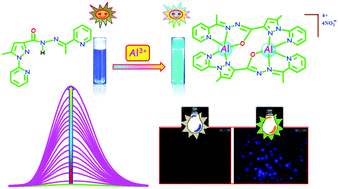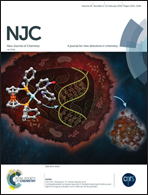A new fluorescence turn-on chemosensor for nanomolar detection of Al3+ constructed from a pyridine–pyrazole system†
Abstract
Herein, a new probe, 5-methyl-1-pyridin-2-yl-1H-pyrazole-3-carboxylic acid (1-pyridin-2-yl-ethylidene)-hydrazide (Hmppc), bearing a pyridine–pyrazole moiety, was synthesized, which offered potential for chemical sensing of Al3+. Investigations of the fluorescence behaviour of Hmppc in DMSO/H2O (2 : 8, v/v) solution under biologically relevant conditions in HEPES buffer (pH = 7.4) displayed a dramatic switch-on response to Al3+ as a result of chelation-induced enhanced fluorescence (CHEF). Detailed experimental studies reveal that Hmppc can detect Al3+ in solution with high sensitivity and selectivity, having a detection limit of 1.2 nM. Furthermore, to demonstrate the analytical potential of Hmppc, we validated our sensing system as a naked eye detector for Al3+. Interestingly, bioimaging studies on HepG2 cells demonstrated that Hmppc responded selectively towards Al3+, allowing real time detection of Al3+ in living cells.



 Please wait while we load your content...
Please wait while we load your content...